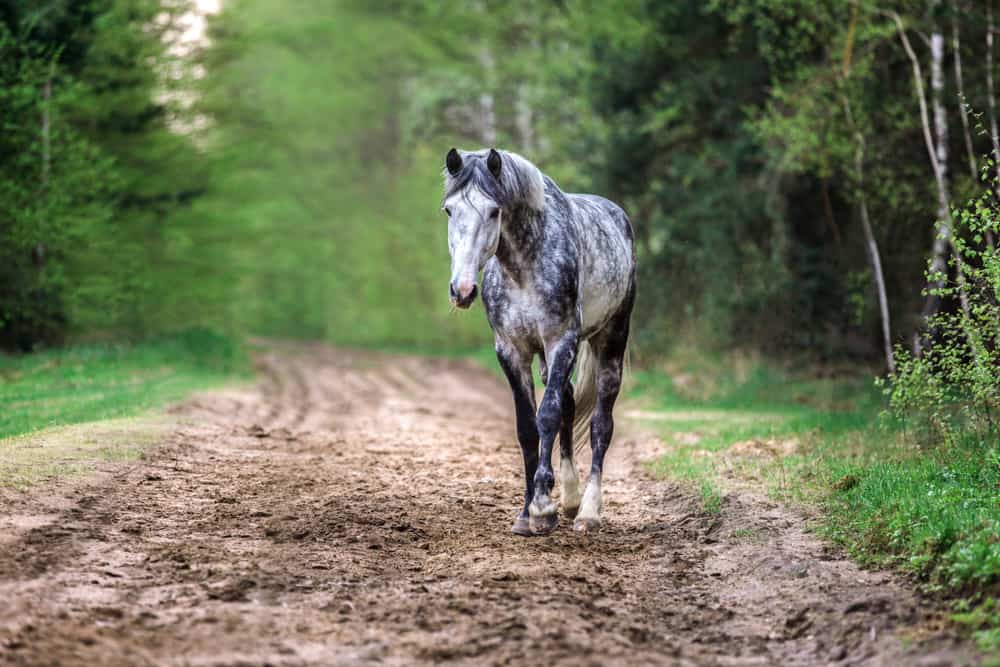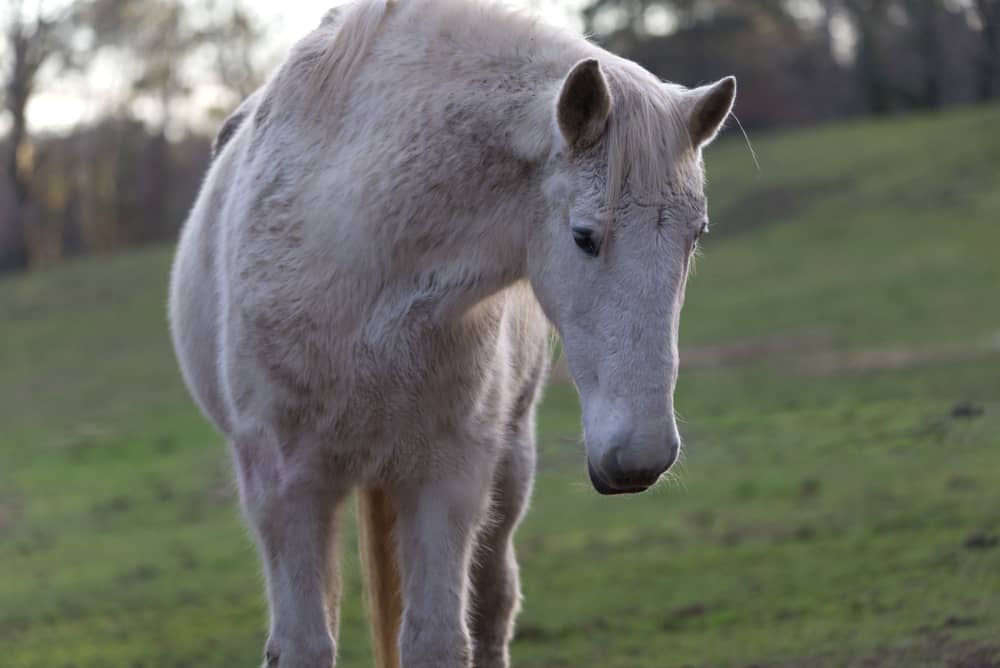- Your source for stall mats, rubber arena footing, arena harrows and arena dust control.

Whether it’s your busy schedule or your horse’s soundness that kept you from riding your horse, bringing your horse back into work after your horse has not been ridden for a long time can be a challenge.
Horses are fine without being ridden at all. However, if your goal is to regularly compete in horse-riding events, there is a certain level of stamina and fitness a horse needs under saddle. Without being ridden, horses can maintain their fitness but will begin to lose conditioning after three weeks of not getting adequate exercise.
Let’s talk about how often your horse needs exercise and what is needed to maintain a certain fitness level in your horse to get your horse back on track after a long break.
How long can horses go without being ridden?
Horses can go for extended periods of not being ridden if they get their exercise in other ways. Riding is a form of exercise for your horse, and if you don’t ride your horse often enough, it can cause problems for your horse’s health. However, horses don’t need to be ridden to be healthy. It is okay for horses not to be ridden, but they will still need some form of exercise to stay healthy.
Horses left out to pasture can get their exercise by walking and running around with other horses. Domesticated horses don’t get the same amount of exercise that their ancestors got. Most modern-day horses stand in a stall or a small pasture all day and don’t get the ability to move around long distances freely.
The horse’s water and food are placed in one place, and the horse may stand there eating for an hour at a time. If your horse is not ridden frequently, exercising your horse is vital to help maintain your horse’s fitness.
How often should your horse be ridden and exercised?
How often you should ride your horse will depend on your riding goals. Horses need exercise to maintain their health and fitness. Whether by being led or ridden, exercising your horse is one of the responsibilities of owning a horse and keeping your horse in top condition. Your horse should get enough exercise to keep his muscles toned and keep your horse’s blood circulation going through his body.
Keeping your horse in top condition requires your horse to get at least two hours of exercise each day. Your horse should be saddled and ridden regularly to keep your horse’s back and girth regions toned.
If you want to ride in high-level competitions, your horse needs an intense training session six days a week. However, if you just want to casually ride your horse for fun and keep your horse in a healthy physical condition, you should ride your horse three times a week for at least 20 minutes at a time.
Casual horse riding
Casual horse riding can refer to a rider who simply likes to get on his horse and ride around for pleasure. While this riding activity may not seem physically challenging, there is still a level of fitness required from the horse to carry you as the rider.
If you are a horse rider who likes to ride your horse casually, you should ride your horse at least twice a week for 20-30 minutes at a time. This amount of riding can help your horse reach the correct level of fitness he needs. This activity should include extended periods of cantering and trotting to get your horse’s heart rate up.
Moderate horse riding
Horse-riders who like to regularly compete in lower-level shows, challenging trail rides, or events should exercise their horses to moderate fitness levels. This level of fitness will guarantee their horses make it comfortably through competition day.
A horse that requires a moderate level of fitness should be ridden four days a week. Two days should include a more intense workout, and the other two days should consist of a slightly easier and less strenuous ride. Riding your horse at this level of exercise will help your horse to develop more prominent muscles.
Performance horse riding
For horses competing in upper-level competitions, they should maintain a certain level of training and physicality. Riding frequency and intensity need to increase drastically. A horse riding at performance level will usually require six days of work a week with one day of rest afterward.
The training sessions for this riding level will be dedicated to perfecting the horse’s technical skill and top-notch physical ability.
Horses that are being ridden at a performance level will have noticeable and prominent muscle development. Horses being ridden at lower levels will not show this level of fitness or muscle development. Horses competing at this level will be monitored closely to ensure their health can handle the level at which they compete.

Lunging your horse
Lunging is a controlled way of exercising your horse without having to ride your horse. Lunging is working your horse in a controlled circle. Your exercise ring should be as large as possible and should have a good ground surface to safely lung your horse.
Lunging a horse takes some skill and experience; exercise should be increased gradually, not to overwork your horse. Lunging should be practiced consistently to maintain a good level of fitness if your horse is not ridden.
Horses should not be lunged for long periods at a time when they have not been active in a while. In the tight lunging circle where the exercise occurs, additional strain is put on your horse’s limbs; proper leg protection for your horse should be used when lunging your horse.
Swimming as a form of exercise for horses
Another form of exercise for your horse without having to ride your horse is swimming. Horses can swim, and this is a good form of exercise for horses that are not ridden. Swimming involves excellent exertion of your horse’s muscles and your horse’s hindquarters.
Letting your horse swim gives your horse a great cardiovascular and respiratory workout. Although a swimming pool for your horse is probably out of reach for most horse owners, swimming is a common feature at racehorse training stables.
Allow a day of rest for your horse to recover
Allow your horse a day of rest to recover, horses just like humans need to rest and recover after any exercise. Especially if your horse was not ridden for an extended time, it is essential to give your horse time to rest and let his muscles adjust and recover from the exercise he has endured.
Not only do horses being ridden on lower levels need to rest, but high-level performance horses do as well. These high-performance horses must maintain an intense fitness level to compete; If they are not allowed to rest, their bodies can get overworked and get injured easily.
Health problems are caused by lack of exercise
Exercising is an essential part of a horse’s daily life and is crucial for stabled horses. The amount and type of exercise your horse needs will be dependent on the work you required from your horse and if your horse has access to outside pasture.
Horses that are kept indoors and confined to their stables for long periods suffer from swelling of their legs; the swelling is caused when fluids build up (edema) due to poor circulation. A horse’s blood flow mechanics, particularly in the lower limbs and hooves, require regular movement for efficient circulation.
Both digestion and circulation are improved by exercise. Horses left in the stable will become constipated, also referred to as “impacted,” and can develop circulation problems.
Lack of exercise leads to boredom and stable vices, and other psychological problems can arise: weaving, cribbing, and stall walking can occur following long periods of confinement.
The most common health problem caused by lack of exercise is a muscular condition known as azoturia, or tying up. “Tying up” results when a fit horse who received regular exercise is left in without proper training and still gets a full ration of feed. Muscle damage can also follow the over-exercise of an unfit horse. Overfeeding and lack of exercise are problematic to any horse.
Conclusion
Horses can go without being ridden for extended periods, and they will be fine. However, horses need exercise to keep their bodies healthy and functioning. There are other forms of exercise your horse can do other than being ridden.
If you are unable to ride your horse frequently, make sure you give your horse at least enough time outside in a pasture so he can get his exercise naturally.
When you decide to bring your horse back into work after an extended time off, make sure you exercise your horse gradually back to his fitness level. Just like an athlete that hasn’t worked out for a while, a horse needs time to build up his fitness after an extended break from work. Remember to give your horse a day off after a workout session to recover.

